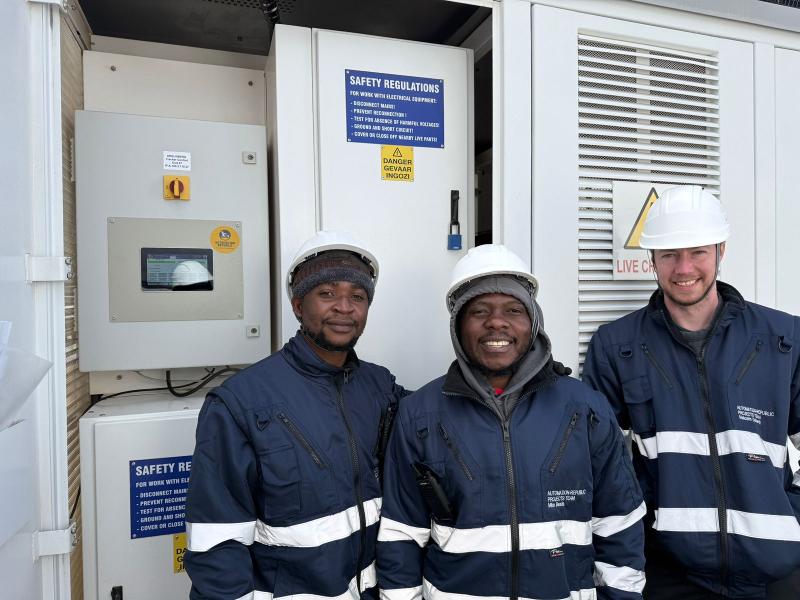Energy Solutions
Our project team has acquired a vast amount of experience working with multiple machines in the energy industry.

Our project team has acquired a vast amount of experience working with multiple machines in the energy industry.

When obsolete hardware was putting one of our clients at risk, our team at Automation Republic took on the challenge—and turned it into an opportunity for smarter, safer, and more resilient solar tracking.
Over the past few months, we’ve successfully completed a comprehensive controller upgrade across multiple arrays, replacing aging systems that had become unreliable due to lightning damage and component obsolescence. Today, the new Automation Republic control platform has been running flawlessly for more than six months, keeping every tracker in sync—and every kilowatt right where it should be.
The original tracker system used a custom RS-485 protocol to communicate between a master controller and six sub-trackers within each array.
To ensure a seamless upgrade, our engineers reverse-engineered the proprietary protocol—allowing our controller to speak the same “language” as the legacy sub-controllers while introducing new layers of intelligence and protection.
Each tracker now operates under a single Automation Republic controller, managing:
Positioning and alignment of up to six arrays per tracker
Real-time data exchange for inclinometers, pressure sensors, and operational modes
Fail-safe command structure that maintains communication integrity across the RS-485 network
In total, 23 trackers at one plant and 44 trackers at another are now running under this new control architecture.
Our new software algorithm and HMI interface are future-proof, designed to keep pace with technological advancements and evolving operational needs.
The upgraded controllers were fully integrated into the plant’s SCADA network via Modbus TCP, replacing the older OPC DA interface.
This shift not only simplified the data exchange layer but also improved reliability and diagnostic transparency for the site’s engineering team.
To make operations safer and more adaptable, we introduced a custom wind-stow angle adjustment feature, giving on-site personnel the ability to fine-tune stow angles directly through the SCADA interface.
The feature was built with strict adherence to the existing safety framework—ensuring all interlocks and protection logic remain intact.


Located near Pofadder, Northern Cape, this solar installation required a major control system upgrade to resolve long-standing performance and reliability issues. The plant’s original configuration was based on a Delta PLC system programmed primarily in Ladder Logic, which led to frequent communication drops, synchronization errors, and ultimately, mechanical gearbox failures due to unbalanced torque loading between linked motors.
The client sought a smarter, more reliable solution capable of handling independent array control, real-time safety monitoring, and robust SCADA integration.
Automation Republic engineered and commissioned a next-generation control architecture using our CM5 CPU module as the new master controller. This modernization replaced the legacy Ladder-based logic with a fully structured logic model running on a high-performance PLC platform.
Modbus TCP Integration — The Delta PLC was converted into a distributed I/O block, removing its program entirely and allowing our CM5 controller to act as the master logic processor.
Dual-Array Logic Implementation — The system was redesigned to treat the structure as two independent arrays instead of one, reducing mechanical stress and preventing gearbox damage.
Dynamic Azimuth Tracking Algorithm — Our PLC performs precise solar position calculations based on latitude and longitude, continuously adjusting the tracker to maintain optimal orientation within a ±55° range.
Weather Station Integration — Real-time weather data is acquired to automatically protect the array under high-wind or storm conditions.
SCADA Connectivity — We configured and commissioned full Modbus RTU (2-wire RS-485) communication to the plant’s existing SCADA system, enabling live monitoring, data logging, and remote control.
PLC Platform: CM5 CPU Module
Protocols: Modbus TCP (I/O link), Modbus RTU (SCADA interface)
Sensors: Inclinometer feedback for dual-axis verification
Safety Integration: Automatic stow under wind or system fault conditions
Control Logic: PID-based position feedback with azimuth correction
Design Focus: Modular logic, fault tolerance, and easy field diagnostics
The upgraded system delivered a significant improvement in reliability and mechanical longevity, virtually eliminating the gearbox failures that plagued the previous setup. Operators now benefit from:
Accurate and independent control of each array
Real-time weather and performance monitoring
Seamless SCADA visualization of system health and motion states
Reduced downtime and maintenance costs
This project showcases Automation Republic’s expertise in modernizing legacy solar infrastructure—merging advanced PLC logic, communications engineering, and mechanical insight to extend the operational life and efficiency of renewable energy assets.
This implementation became a defining project for our engineering team—demonstrating the logical and mathematical depth required in the solar industry and affirming our capability to solve complex, multi-disciplinary challenges through precise, data-driven control engineering.
 Energy Capacitor Management System
Energy Capacitor Management SystemWe developed a bespoke solution for a unique customer, on a revolutionary battery system that promises to change the way batteries are developed in the future.
Due to the lack of lithium resources available and the need for a new solution, our customer developed a new battery solution that utilises specially designed capacitive cells, which drastically increase the power density for a given size unit.
The challenge he faced was using a standard BMS system that would work with conventional lithium batteries. These units do not work with Capacitive Cells.
We were tasked with developing a CMS (Capacitor management system) that will communicate with an SMA inverter (Sunny Island 6.0) that is widely used in industry via CANBUS.
Our system was able to successfully communicate with the required protocols from the inverter and is now the 1st of many capacitive battery systems developed fully in South Africa. The system is online and supplying power to his factory, which is built to create more of these special batteries. The Automation Republic team used a combination of communication platforms, web server integration, microcontrollers, GPS tracking and IoT platforms to achieve all the requirements.